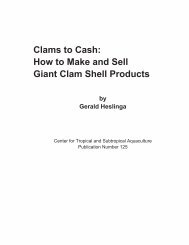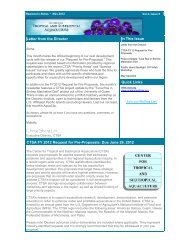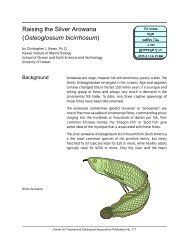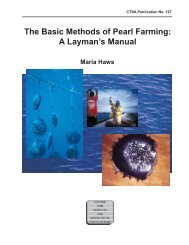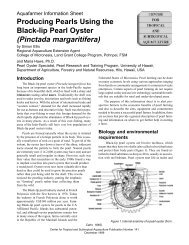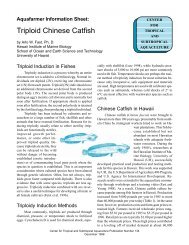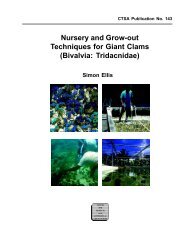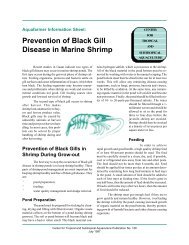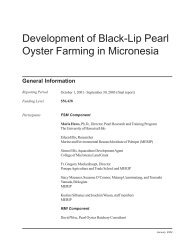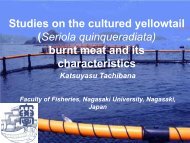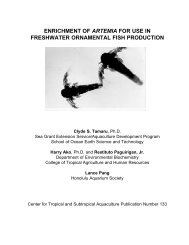Letter from the Director Cheng-Sheng Lee In This Issue ... - CTSA
Letter from the Director Cheng-Sheng Lee In This Issue ... - CTSA
Letter from the Director Cheng-Sheng Lee In This Issue ... - CTSA
You also want an ePaper? Increase the reach of your titles
YUMPU automatically turns print PDFs into web optimized ePapers that Google loves.
deep water where <strong>the</strong>y exist, as many people have been swept away and drown while collecting<br />
opihi. For this reason, opihi have been called <strong>the</strong> "fish of death".<br />
<strong>In</strong> our first year of study we have turned opihi aquaculture <strong>from</strong> an unknown to a standard<br />
aquaculture research object. We began our study with collection of animals <strong>from</strong> <strong>the</strong> wild. We first<br />
encountered high mortality (58%) within few days (3-4 days) after collecting. We presumed <strong>the</strong><br />
mortalities occurred due to injury while prying opihi off <strong>the</strong> rocks. We tried to detach <strong>the</strong>m quickly<br />
before <strong>the</strong>y became alarmed and would cling more tightly into <strong>the</strong> rocks. We obtained 82%<br />
survivors by <strong>the</strong> fourth collection.<br />
An additional high mortality of 53% occurred while transferring animals <strong>from</strong> one holding tank to<br />
ano<strong>the</strong>r because <strong>the</strong> animals attached tightly to <strong>the</strong> wall of <strong>the</strong> tank and were hard to get off. We<br />
auditioned several tank liners. The one we settled on was sold as a dropcloth for painting (Fig 1).<br />
Later soft plastic colanders were used (Fig. 2). Both tanks overlaid with plastic liner or colanders<br />
reduced this mortality to zero in subsequent experiments because animals could be easily removed<br />
<strong>from</strong> <strong>the</strong> wall of <strong>the</strong> tank by gently deforming <strong>the</strong> plastic. They would fall off and could be picked up<br />
by hand.<br />
We <strong>the</strong>n focused on trying to deduce <strong>the</strong> preferred feed of opihi by investigated <strong>the</strong> natural food by<br />
stomach content analysis. Stomach contents contained benthic diatoms (about 30% of <strong>the</strong> materials<br />
seen), bacterial clumps and o<strong>the</strong>r un-identifiable particles. Twenty diatom species were seen and<br />
<strong>the</strong> most frequently seen were Bacillaria sp, Fragilaria sp, Melosira sp, Navicula, sp and<br />
Rabdonema sp. We subsequently were able to culture <strong>the</strong>se algae and would hold <strong>the</strong> animals for a<br />
while feeding on <strong>the</strong> biofilm. Opihi fed at 0.47% dry matter/bodyweight/day on cultured diatoms.<br />
We began our studies on artificial feeds with sea urchin feeds. We were not able to get <strong>the</strong> opihi eat<br />
enough to keep <strong>the</strong>mselves alive. We tried o<strong>the</strong>r diets containing fish meal and soy bean meal.<br />
Fishmeal and soy meal tended to be preferred and betaine did not serve as a feeding stimulant (Fig.<br />
3). Gamma aminobutyric acid (GABA), and dimethyl propio<strong>the</strong>tin (DMPT) and Spirulina did not<br />
enhance feeding ei<strong>the</strong>r. Biofilm incorporation into <strong>the</strong> feed stimulated feeding.



